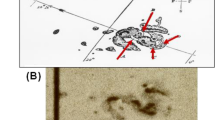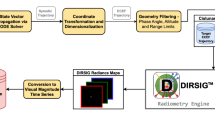Abstract
The results of a scientific and educational experiment on the SiriusSat-1 and SiriusSat-2 spacecraft carried out in Russia in the format Cubesat 1U+ are presented. The launch of two Sirius Sat-1,2 spacecraft was carried out on August 15, 2018 by astronauts from the ISS. The payload of the SiriusSat satellites is a detector based on several optically connected scintillators; it registers charged particles and \(\gamma\)-quanta in the energy release range of 0.3–3 MeV. The measurement mode provides both second-by-second monitoring and a detailed mode fixing the energy of each particle or quantum, as well as the corresponding time instant with a microsecond accuracy. Each satellite transmits \({\sim}100\) kB of scientific data daily, which are available on the space weather server of the Skobeltsyn Institute of Nuclear Physics, Moscow State University. During the flight, the variations in the precipitating and quasi-trapped electron fluxes of the outer Earth radiation belt and at the border of the South Atlantic Anomaly, and the dynamics of the particle fluxes and gamma rays depending on geomagnetic conditions have been studied. Additional possibilities are provided by the analysis of the passage of the areas of captured or precipitating particles by two closely flying satellites.




Similar content being viewed by others
REFERENCES
R. M. Millan, R. von Steiger, M. Ariel, et al., Adv. Space Res. 64, 1466 (2019).
Yu. I. Logachev, Priroda, No 12, 12 (2017).
A. V. Bogomolov, Yu. I. Logachev, M. I. Kudryavtsev, et al., Izv. Akad. Nauk, Ser. Fiz. 61, 1129 (1997).
L. S. Bratolyubova-Tsulukidze, E. A. Grachev, O. R. Grigoryan, and O. Yu. Nechaev, Cosmic Res. 39, 564 (2001).
I. N. Myagkova, A. V. Bogomolov, and Yu. S. Shugai, Mosc. Univ. Phys. Bull. 65, 234 (2010). https://doi.org/10.3103/S0027134910030173
V. O. Barinova, A. V. Bogomolov, V. V. Kalegaev, I. N. Myagkova, M. I. Panasyuk, I. A. Rubinshtein, M. O. Ryazantseva, and L. I. Starostin, Mosc. Univ. Phys. Bull. 66, 616 (2011). https://doi.org/10.3103/S0027134911060038
V. A. Sadovnichy, M. I. Panasyuk, I. V. Yashin, et al., Solar Syst. Res. 45, 3 (2011).
M. I. Panasyuk, S. I. Svertilov, V. V. Bogomolov, et al., Cosmic Res. 54, 261 (2016).
M. I. Panasyuk, S. I. Svertilov, V. V. Bogomolov, et al., Cosmic Res. 54, 343 (2016).
A. V. Bogomolov, I. N. Myagkova, V. V. Kalegaev, S. I. Svertilov, V. V. Bogomolov, M. I. Panasyuk, V. L. Petrov, and I. V. Yashin, Cosmic Res. 55, 446 (2017).
I. N. Myagkova, S. I. Svertilov, A. S. Kovtyukh, V. V. Bogomolov, A. V. Bogomolov, M. I. Panasyuk, D. V. Sibiryakova, and E. V. Balan, Cosmic Res. 55, 72 (2017). https://doi.org/10.7868/S0023420617010071
A. S. Kovtyukh, I. N. Myagkova, V. V. Bogomolov, et al., Geomagn. Aeron. 56, 700 (2016). https://doi.org/10.7868/S0016794016060109
A. V. Bogomolov, Yu. I. Denisov, G. Ya. Kolesov, M. I. Kudryavtsev, Yu. I. Logachev, O. V. Morozov, and S. I. Svertilov, Cosmic Res. 43, 307 (2005).
A. V. Bogomolov, V. V. Bogomolov, Yu. I. Denisov, et al., Izv. Akad. Nauk, Ser. Fiz. 63, 1665 (1999).
V. L. Petrov, A. V. Bogomolov, V. V. Bogomo https://doi.org/oi 10.31857/S001679402002011X
M. Shumko, A. T. Johnson, J. G. Sample, et al., J. Geophys. Res.: Space Phys. 125, e2019JA027651 (2020). doi 10.1029/2019JA027651
A. B. Crew, H. E. Spence, J. B. Blake, et al., J. Geophys. Res.: Space Phys. 121, 5272 (2016). https://doi.org/10.1002/2016JA022485
M. I. Panasyuk, M. V. Podzolko, V. V. Kalegaev, et al., Mosc. Univ. Phys. Bull. 73, 687 (2018). https://doi.org/10.3103/S0027134918060206
A. W. Breneman, A. Crew, J. Sample, et al., Geophys. Res. Lett. 44, 11265 (2017). https://doi.org/10.1002/2017GL075001
I. N. Myagkova, V. V. Kalegaev, M. I. Panasyuk, et al., Proc. IAU Symp. 335, 232 (2017). https://doi.org/10.1017/S1743921317010456
M. I. Panasyuk, V. V. Radchenko, A. V. Bogomolov, et al., in Space Workshop, Ed. by A. S. Kovtyukh, 2nd ed. (Universitetskaya Kniga, Moscow, 2006) [in Russian].
Author information
Authors and Affiliations
Corresponding authors
Additional information
Translated by E. Smirnova
About this article
Cite this article
Bogomolov, V.V., Bogomolov, A.V., Dement’ev, Y.N. et al. A Scientific and Educational Space Experiment on the SiriusSat-1,2 Satellites. Moscow Univ. Phys. 75, 665–675 (2020). https://doi.org/10.3103/S0027134920060077
Received:
Revised:
Accepted:
Published:
Issue Date:
DOI: https://doi.org/10.3103/S0027134920060077




